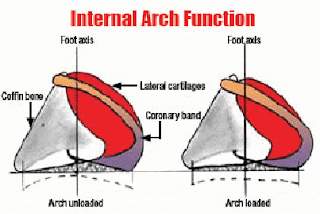When it comes to the hoof capsule, stability defines its health. The hoof wall is a matrix of epithelium and within that matrix are primary tubules originating at the coronary band and laminar derived inter-tubular horn originating at the lamellae.
The ratio of tubule to lamellae derived horn defines the walls primary function at any given location in the hoof wall. For example: The toe region of the hoof capsule has a high ratio of primary tubules to that of laminar derived horn, this when compared to the heel area of the hoof capsule. Primary tubules resist distortion, whereas lamellae derived horn is well suited to distortion and buffering. You see primary tubules provide the stability to the matrix much like re-bar to concrete. Primary tubules produced a the coronary band are quite dense.
Foundation, Foundation, Foundation
We must look to the foundation of a structure to truly understand the why of its make-up. The foundation of the toe is the coffin bone, where as the heel has a foundation of cartilage. It is a fact that the foundation of the caudal (back) hoof is cartilage and the foundation for the dorsal foot is bone. With a high ratio of tubules to lamellae derived horn in hoof wall surrounding the coffin bone we can deduce that the function of the toe is one of support and protection. Not physical support, but rather to support locomotion. Protection comes in the form of stabilization, helping to reduce torque about the coffin bone and with a layer of lamellae derived horn between the coffin bone and the hoof wall matrix a buffer is created to protect the dermis.
Looking at the heels we find a foundation of cartilage. The hoof wall in the heel has a matrix comprised of a high ratio of lamellae derived horn to that of primary tubules. This ratio allows for distortion to occur in the caudal foot, while protecting the dermis by way of buffering the shock created at impact.
Why do we want distortion in the caudal foot?
The simplest of answers is; because of the foundations of the foot. Cartilage throughout the body is often present to protect bone and this is true of the Ungular Cartilages of the equine foot. Cartilage health plays a major role in protecting the coffin bone and navicular apparatus from torque.
How did I come to this conclusion? By asking another simple question: Whys is the frog a triangle? Or Why is the Frog Stay a "V". As I stated earlier function is defined by a structures conformation and the property of its tissue. The foundation of the frog stay (inclusive of the bars) is essentially Ungular Cartilage. When I lectured at the National Farriers Conference in Normandy France I presented an analogy to help explain the function of the Ungular Cartilages.
I related the coffin bone to a tow vehicle and the ungular cartilages as a horse box (trailer). The union of the cartilage to bone was portrayed as a hitch with stabilizer bars. The function of the trailer hitch was to reduce or eliminate torque on the vehicle. The stabilizer bars (springs) provided elastic potential to stabilize movement and further reduce uncontrolled movement on the vehicle. Cartilage has the same function. Having a high elastic potential cartilage effectively reduces torque on the coffin bone and the navicular apparatus. I pointed out that stabilizer bars allow for optimal performance in towing and if they are removed excessive movement can occur placing strain on the vehicle. I also pointed out that if the hitch was to be welded solid the vehicle would be exposed to extreme torque and strain. I know this is a simplistic way of looking at function, but it often helps my students understand the difference between Stabilization, Instability, and Immobilization.
With this understanding my students are able to evaluate the vast array of bar shoes, flexible shoes, pad, and boots being used on horses today.

 A foot stricken with instability due to weak cartilages will not do well in a flexible horse shoe, simply because unrestricted movement can be detrimental. Such a foot will not do well in a bar shoe either. The reason; because cartilage needs pressure to maintain or return health. Cartilage does not derive its nourishment directly from the circulatory system, so increasing circulation by loading the frog or allowing for expansion does not suffice. Cartilage needs to be stabilized not immobilized. How is this done? By providing stability through support with elastic potential. There are many products out there that can provide dynamic stability through elastice potentional to the weak hoof, using titanium shoes or steel (spring) shoes are two ways. The product pictured is Perfect Hoof Wear, a polyester wrap. Our students learn that an unstable foot can be stabilized by using the PHW and adding a flexible horseshoe to the wrap
A foot stricken with instability due to weak cartilages will not do well in a flexible horse shoe, simply because unrestricted movement can be detrimental. Such a foot will not do well in a bar shoe either. The reason; because cartilage needs pressure to maintain or return health. Cartilage does not derive its nourishment directly from the circulatory system, so increasing circulation by loading the frog or allowing for expansion does not suffice. Cartilage needs to be stabilized not immobilized. How is this done? By providing stability through support with elastic potential. There are many products out there that can provide dynamic stability through elastice potentional to the weak hoof, using titanium shoes or steel (spring) shoes are two ways. The product pictured is Perfect Hoof Wear, a polyester wrap. Our students learn that an unstable foot can be stabilized by using the PHW and adding a flexible horseshoe to the wrap for performance.

